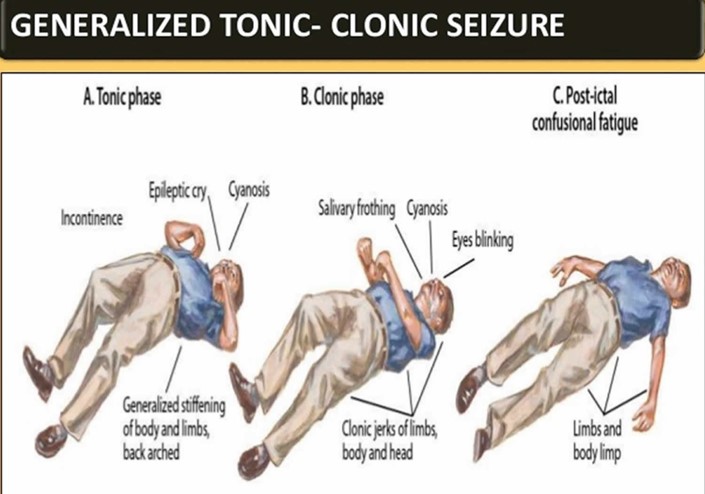The practical nurse (PN) is caring for a child who was admited after experiencing a generalized tonic-clonic seizure. When witnessing the child begin the seizure, what should the PN implement immediately? (Select all that apply)
Observe the progression of the seizure
Hold the extremities close to the body
Insert a tongue blade between the teeth
Pad the side rails with pillows
Loosen clothing around the neck
Correct Answer : A,D,E
The correct answers are:
a) Observe the progression of the seizure.
- Pad the side rails with pillows.
- Loosen clothing around the neck.
Explanation: During a generalized tonic-clonic seizure, it is important for the practical nurse (PN) to prioritize the safety and well-being of the child. The correct actions to implement immediately are:
a) Observe the progression of the seizure: The PN should closely observe the seizure to gather important information that can be helpful for medical professionals in assessing the seizure's characteristics and duration.
- Pad the side rails with pillows: Padding the side rails of the bed with pillows helps to prevent the child
from injuring themselves by hitting the side rails during the seizure.
- Loosen clothing around the neck: Loosening any tight clothing around the child's neck helps to ensure adequate breathing and prevent any constriction or discomfort during the seizure.
- Hold the extremities close to the body: This action is not recommended during a seizure as it may increase the risk of injury to the child or the PN.
- Insert a tongue blade between the teeth: It is not recommended to insert any object, including a tongue blade, between the teeth of a person experiencing a seizure. This can cause injury to the person's mouth or teeth and is no longer considered an appropriate intervention for seizures.

Nursing Test Bank
Naxlex Comprehensive Predictor Exams
Related Questions
Correct Answer is A
Explanation
A. This finding requires immediate action, as it indicates that the client is not receiving the prescribed amount of oxygen, which can compromise the oxygenation and perfusion of the tissues. The PN should adjust the flowmeter to deliver 3 liters per minute of oxygen, and check for any leaks or kinks in the tubing.
The other options are not correct because:
B. The absence of a humidifier does not require immediate action, as it is not a critical component of the oxygen delivery system. A humidifier can help moisten the dry oxygen and prevent mucosal irritation, but it is not essential for oxygenation.
CThe supine position does not require immediate action, as it is not a contraindication for oxygen therapy. The client may prefer this position for comfort or rest, and it does not affect the oxygen delivery or uptake.
D . The snug fit of the cannula does not require immediate action, as it is not a problem for oxygen therapy. The cannula should fit snugly against the client's cheeks to prevent dislodgment or slippage, and it does not interfere with the oxygen flow or diffusion.
Correct Answer is A
Explanation
Choice A rationale:
Assigning a client who is one day postoperative for a laparoscopic cholecystectomy to the practical nurse (PN) is appropriate. This procedure is minimally invasive, and the client is likely stable, requiring routine postoperative care such as wound assessment, pain management, and monitoring for any signs of complications.
Choice B rationale:
An older client who is one day postoperative with a colostomy for colon cancer may have complex postoperative needs, including colostomy care, monitoring for complications, and pain management. This level of care is usually within the scope of the registered nurse (RN) rather than a practical nurse (PN).
Choice C rationale:
An older adult who is scheduled for foot amputation due to diabetes complications is likely to have complex care needs, including wound care, diabetes management, and potential complications. This client would require the expertise of an RN rather than a PN.
Choice D rationale:
An adult with alcoholism, cirrhosis, and hepatic encephalopathy may have complex medical and psychosocial issues that require specialized nursing care. This client's condition is not appropriate for a practical nurse (PN) to manage, and the care should be provided by an RN or other specialized healthcare provider.
Whether you are a student looking to ace your exams or a practicing nurse seeking to enhance your expertise , our nursing education contents will empower you with the confidence and competence to make a difference in the lives of patients and become a respected leader in the healthcare field.
Visit Naxlex, invest in your future and unlock endless possibilities with our unparalleled nursing education contents today
Report Wrong Answer on the Current Question
Do you disagree with the answer? If yes, what is your expected answer? Explain.
Kindly be descriptive with the issue you are facing.
